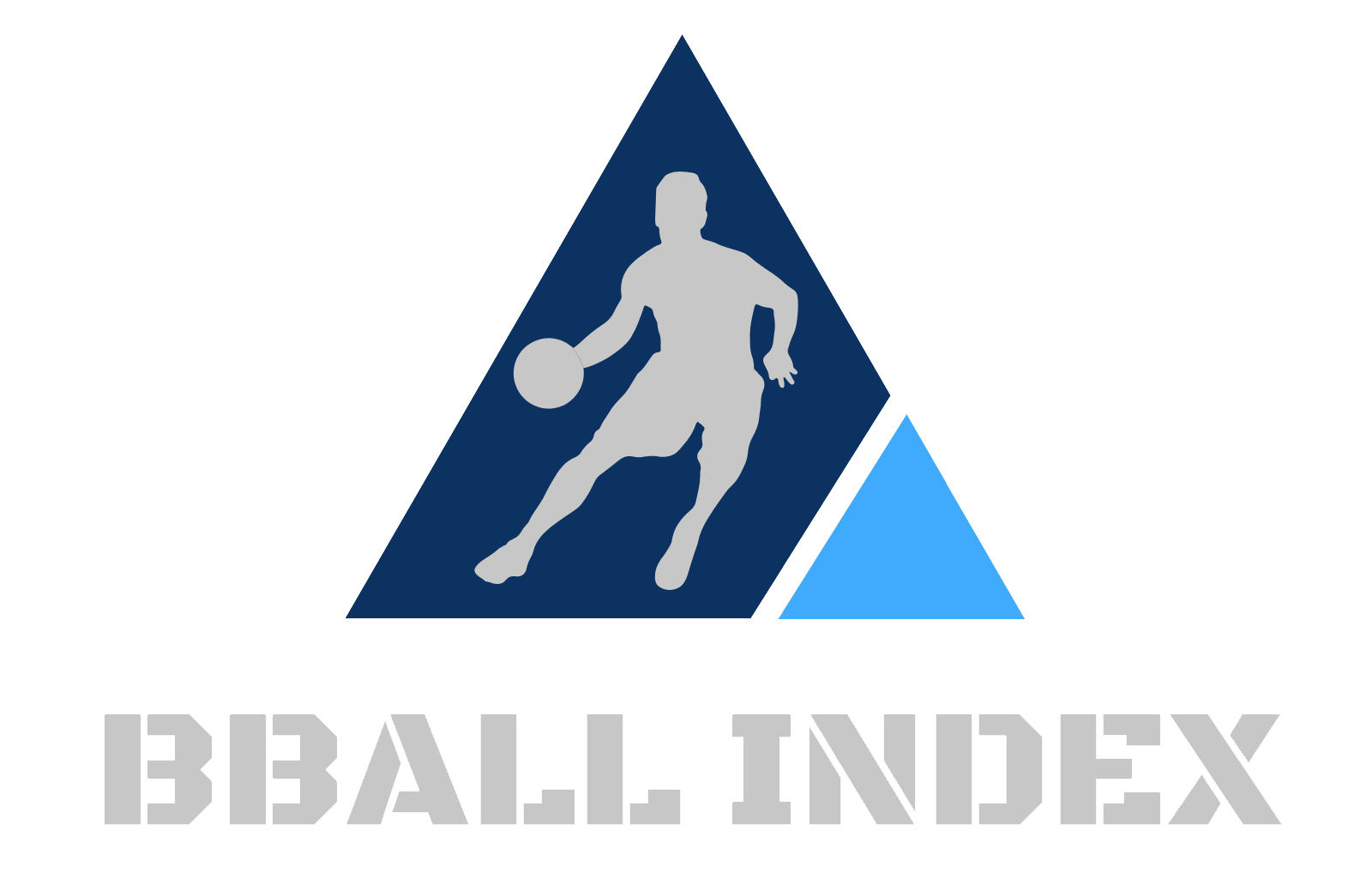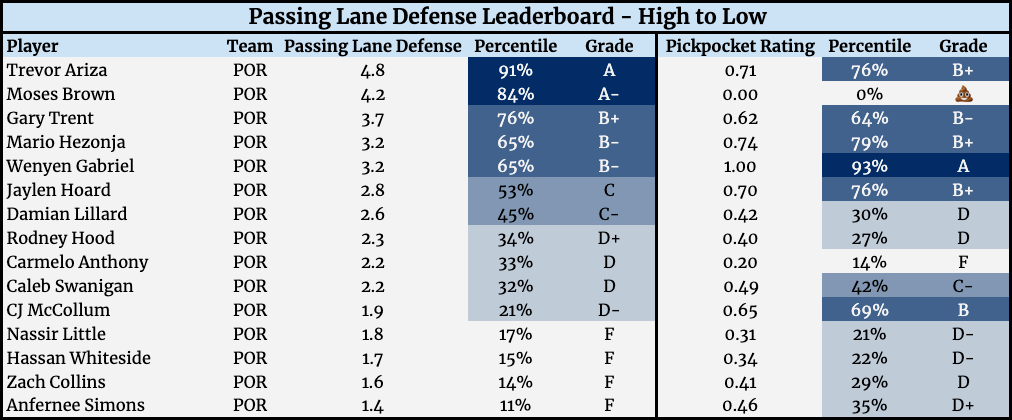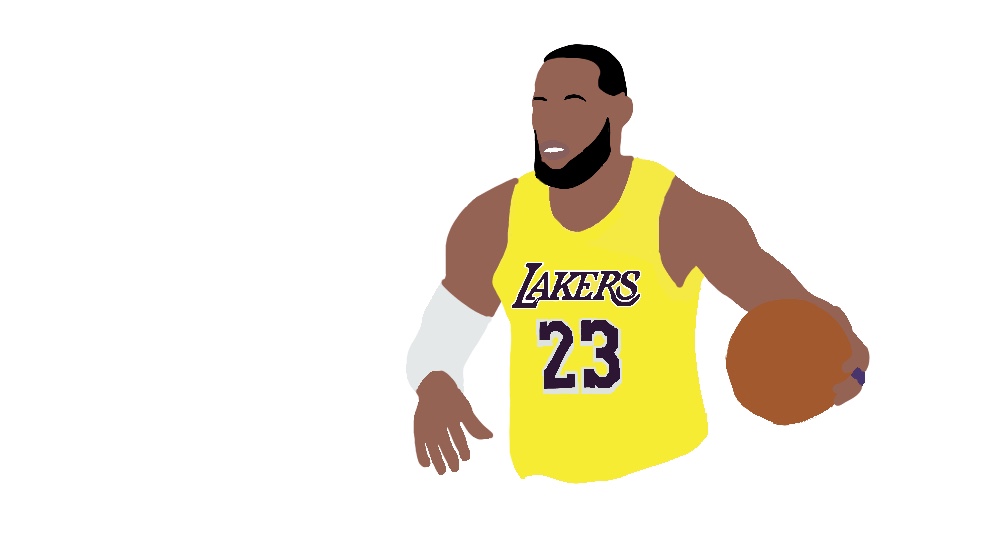
Lakers playoff basketball is BACK!
It’s finally here, and I’ll be here to help break down the Lakers’ playoff series for you, starting with round 1, Blazers vs Lakers.
Portland has the best rapper in this matchup, but LA has the best two players and enters the series as a heavy favorite. The Lakers come in with the West’s top record and have dominated top teams this year, but playoff basketball isn’t the same animal.
Playoff matchups, where you repeatedly play the same team time after time, create the opportunity for teams to up their game planning substantially and implement approaches that there just isn’t as much time to practice and use during the regular season with opponents constantly changing. The staffs in this matchup lie somewhere in the middle of the Nick Nurse to Mike Budenholzer tactical prowess spectrum. I don’t anticipate a huge boost in that regard for either team like Toronto has gotten from Nurse & Co., nor do I expect a lack of adjustments nearly as detrimental as Atlanta and Milwaukee have experienced with Budenholzer in the past.
That said, there is plenty to be aware of and look out for. I’m writing this analysis from the perspective of a Lakers analyst and will frame the advice in that manner. To aid this analysis, I’ve broken down the film for all of Portland’s bubble games and leveraged a ton of data (much from our $5/month Data & Tools package) to derive my recommendations. I’ll release notes on what’s happened and next steps regarding adjustments once the series begins.
Here’s what you’ll read in this breakdown:
- Analysis on Portland’s most frequently used plays, and how I’d game plan against them
- Analysis on Portland’s most used actions and how I’d game plan against them
- Notes on key Blazers players
- Strengths and vulnerabilities in the Portland defense
Defending Portland’s Top Plays
Portland doesn’t run a lot of set plays, so I picked five I saw run frequently to highlight. Much of what the Blazers do is simple pick and roll basketball, and when these plays don’t work they’ll often flow into that.
Play 1: Double Fist
I’ll start off by noting that the verbiage here isn’t violent for the sake of being violent, but is actually terminology used across basketball coaching (which is widespread and decentralized, so you’ll find other terminology out there as well). The “double” piece of this refers to having two players, and “fist” means ball screen.
Here’s what the set looks like:
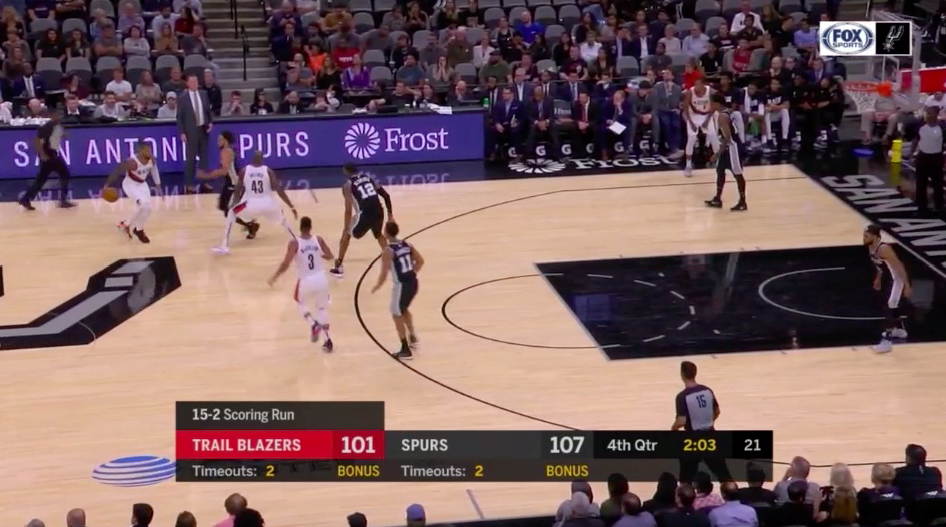
It’s a fairly simple play, and in line with them liking to use a lot of pick and roll, but it’s still an organized set. Portland wants shooters in the corners to space the floor, and both bigs setting the high ball screens. That results in 0 defenders protecting the rim if Dame is able to get downhill.
The goal for this play, as it is for any play, is either to get an open shot for the ball handler, get a mismatch, or to get two defenders on the ball with the open man in a position to cause damage.
Dame on this play has shown an aptitude to pull up and shoot a deep 3-pointer after either the first or second screen if the defensive bigs in the action sink too deep. The other way Dame scores on this play is by going downhill, either after the first or second ball screen. Having both screens gives him the flexibility to pick from several options, based on what the defense concedes.
Portland will run this set with all kinds of variations with their bigs and in different orders, but expect Melo and Collins to be poppers and their other bigs to roll.
If this play seems familiar, it may be because the Lakers have used it themselves in the past. You can see a breakdown of the options the play allows by LakerFilmRoom in his 2016 video here.
The reason this play is tricky is that it puts three defenders in the action together, which requires a more coordinated effort to be sound and not give up the wrong looks to the offense. Here are a couple examples of reads that could be made:
- If Dame’s man goes under the screen and the two bigs play drop coverage, you’re conceding a 3-point shot to Dame.
- If Dame’s man goes over the screens and the bigs hard hedge, the first screener should have a wide open lane to roll and get a bucket or can be open on a pop.
- If Dame’s man ices the screen and tries to get him to reject, but the bigs aren’t on the same page and don’t drop, that’s an easy downhill drive against no rim protection other than players covering shooters in the corners.
So what’s the best way to stop it? Here’s the plan:
- We’re going to have slightly different execution based on how the offense lines up, but no matter what, we’re looking to funnel Dame toward AD on his off-hand side while keeping him from taking a pull up 3-pointer. Based on that:
IF AD is the defender for the first screener:
- Ice the first ball screen with Dame’s man, meaning his guy will jump out to get in the way of where Dame would want to dribble, forcing him to reject the ball screen. This also is in line with LA’s normal “weak” ball screen defense, where they try to get a ball handler dribbling to their weak side. Coincidentally, I almost exclusively saw this play run from left to right, so making Dame go left aligns with LA’s normal principles.
- AD shows hard rather than dropping and switches onto Dame, looking to immediately negate attempts for a pull up 3 or a blow-by. I feel confident in AD’s ability to cover this ground more than Howard/McGee would.
- The man for the second screener zones up in a drop to take away a roll from either screener. His responsibility is defending the rim from the screeners. If either of them cut, he drops to cover.
- Dame’s original defender, the guard who iced the ball screen, takes the 4 in this situation and leaves the 5 to the other LA big that’s currently zoning up. If one of the screeners rolls, and takes the non-AD big with him, this man takes whoever is left.
IF AD is the defender for the second screener:
- Dame’s defender goes over the first screen. If he goes under or lets Dame reject the ball screen, LA is vulnerable to a pull-up 3-point attempt or a drive to the rim.
- LA’s man guarding the first screener (who isn’t AD), shows hard to ice the second screen. Brooklyn did this in a different but similar play several times and it negated the action for Portland. We want Dame needing to go in between the two screens, in lots of traffic, toward AD, all to his left weak side.
- AD plays center field and takes on any Dame drive, while LA’s guard looks to get back in front of Dame so AD can recover to his man.
- The other LA big that iced the second ball screen takes on that second screener as their man.
Play 2: Mover-Blocker Wheel
This play is one Portland has used for several years and will look familiar to UVA fans in the college game. It fits Portland’s personnel well because they have two guards who can attack well in off-screen and ball screen situations, and have Bigs that can set good screens and you don’t generally want running post ups.
Here’s what the play looks like:
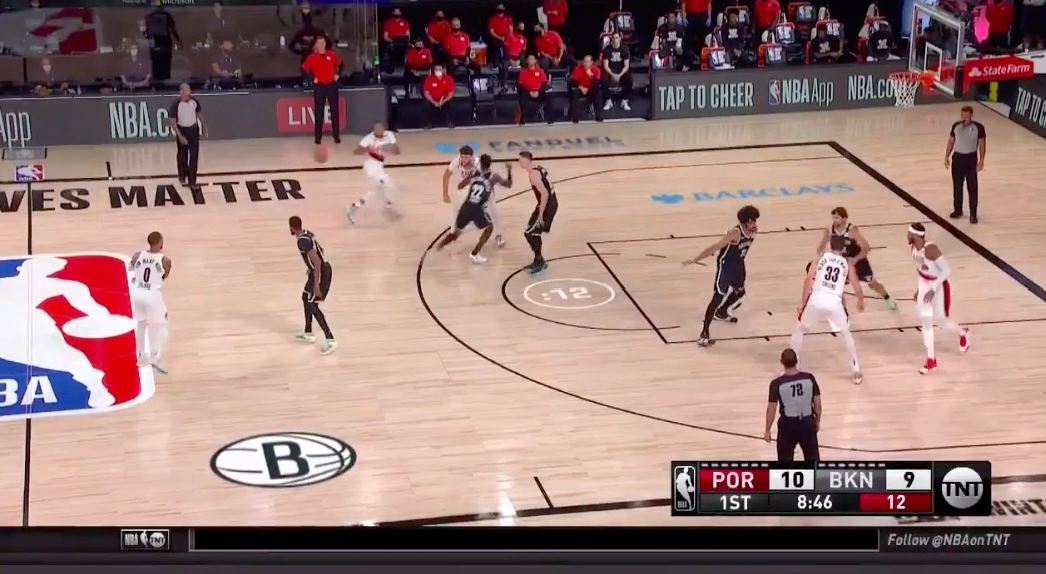
At the point the clip is briefly paused we see two actions happening simultaneously. We have a flare screen for McCollum at the top of the screen at the same time we have a pin down for Carmelo at the bottom of the screen. Brooklyn chooses to go under both screens, and gives up the CJ 3-point attempt.
If either action caused 2 defenders to defend the scoring option, the screener in that action should slip to the rim. If Nurkic’s man were to sink down, Nurkic would go set a ball screen in a 2-on-1 situation where Dame gets a pick & roll without any hedge, which is deadly. If neither action produced a good look, Melo would receive the pass from Dame and then CJ would come off the pin down as Dame went off the flare. Those three “movers” produce that circular wheel action as the two “blockers” screen continuously. But Portland usually gives it one go and then sets a ball screen or goes iso.
For this play I want to “lock and trail” the flare screen to try to take away the 3-point look. What that concedes is a curl to the rim, but that’d be something McCollum has done only 6 times in 70 total games this season, Dame has done once, and Melo hasn’t done at all. So that likely locks that action down.
For the pin down, I want to go under the screen and concede either a fade to the 3-point line (which Portland hasn’t done much at all this season) or for the scorer to have to fire a catch and shoot 2-pointer immediately. If Portland starts fading that, then I’d look to lock and trail. But that’s easier to get the ball to and then attack downhill, so it wouldn’t be my first choice.
No matter what, I don’t want to give up a ball screen without a screener, an open 3-point attempt, or an easy slip to the rim by one of the two screeners. We’re doing our job if we can force mid range pull ups or negate the action completely.
Play 3: Zipper Punch
This isn’t that impressive of a play, but it does set up other action Portland runs out of a similar starting point. A “zipper cut” is the Guard/Wing cutting to the 3-point line off of the post player, which isn’t a scoring action I’m at all concerned about (it’s more to counter a defense denying that player the ball, which we’re not doing). Then the ball gets entered to the post player. Portland runs it out of their sideline out of bounds and also as a normal set. Here’s what it looks like:
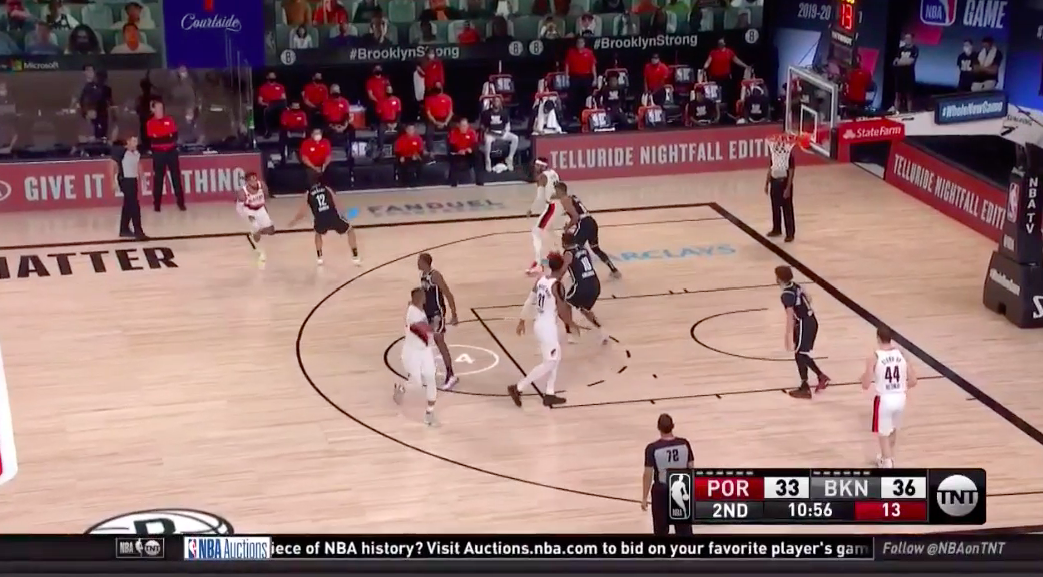
Since the zipper isn’t a real scoring action, we definitely won’t switch and concede a mismatch down low. And if there’s no switch, I’m happy with LA’s defense against any of Portland’s post scorers, so I don’t feel the need to get fancy with any double teams or anything more creative than normal shell defense.
Another reason I’m fine with letting this play run as normal without looking to disrupt is how infrequently Portland tries to do anything off-ball during the post up. Being stagnant makes it less likely to produce good offense, and also makes it easier for us to decide to be creative and double if Portland does end up having a mismatch down low we need to revisit after game 1.
Player 4: Zipper Pin Punch
This play is a counter to the Zipper Punch, if by counter we only mean it starts the same. Nothing about how we’d look to defend Zipper Punch makes us vulnerable to how this play is run, so it’s not a true counter in how I’d categorize one.
Anyways, Portland passes to the zipper in this play, then sets a pin down opposite. After that pin down, if there’s no immediate shot, they pass to the screener of the pin down, who ducks in and posts up. Here’s what it looks like:
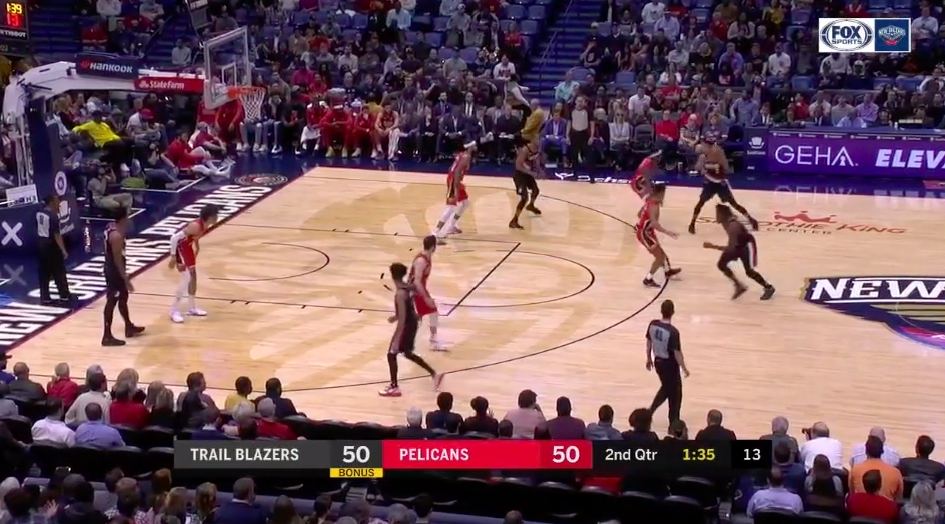
This play is tricker because of the pin down right before the post up. What we don’t want to do is switch the pin down and have a situation where KCP is defending a big in the post, because that’s a mismatch that’ll generate good offense for Portland.
Instead of switching, which would also make a slip from the screener a vulnerability, we want to lock and trail this pin down the same way we see Portland defend the action. The goal would be to let Portland attack with their post up as the rest of their stagnant offense and two dynamic scoring guards watch.
Play 5: Secondary Break Step Up
This play is another simple ball screen, and was one of the few bright spots schematically from Jesse Mermuys’ scheme we saw Luke Walton implement in LA for a few years and one that has carried over to the new regime (albeit less often used).
This is a “secondary break” play because while it’s not a fast break, we have a defense that is still getting in position and more susceptible to step up ball screens, drag screens, quick pins, and flare screens. This play takes advantage of that. Here’s what it looks like:
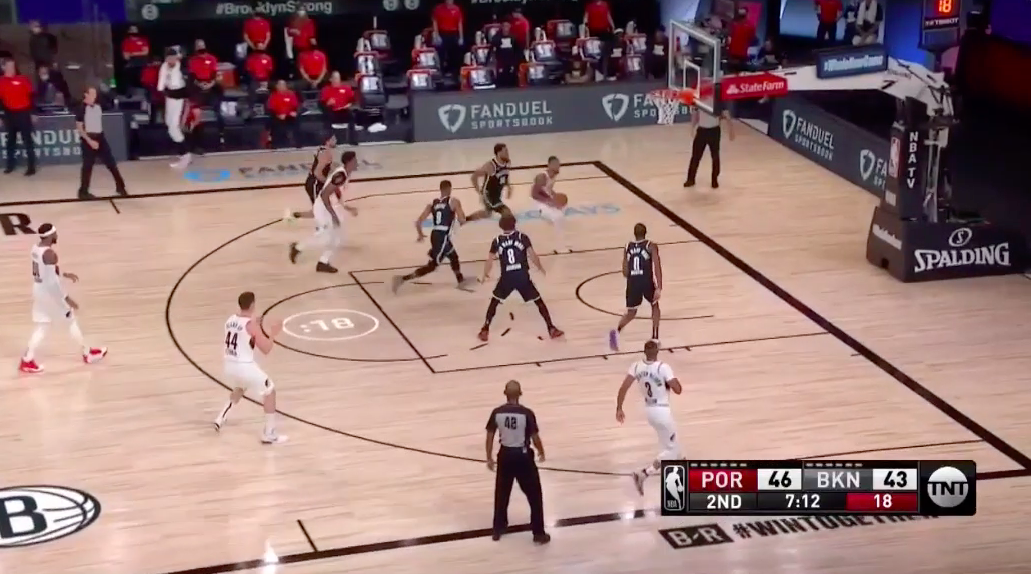
Because Dame is getting downhill and the rest of our defense isn’t set, showing hard or doubling opens us up for Dame to split the defenders and attack the rim. Against other players it might be a more automatic answer, but Dame splits defenders in ball screens more than anyone in the NBA other than James Harden, and CJ does it fourth most of all players. If we drop too deep, that gives up the pull up 3-pointer. And I’m not thrilled if we switch with Howard or McGee as the defender.
Because of that, this is a blitz situation to me. If Dame can split the pick and roll consistently, which he’s done more than most players but still only about once every four games, we look to switch against it instead.
Those are some of the sets Portland will run against the Lakers. Now let’s get to specific actions and attacks that are worth game planning against.
Defending Portland’s Top Actions
Here are Portland’s most used scoring play types per game and a note on their efficiency/impact, sorted by scoring possessions per game:
- 13.7 Dame Pick & Roll – 95th percentile efficiency
- 8.1 McCollum Pick & Roll – 71st percentile efficiency
- 4.9 Anthony Post Up – F impact
- 4.5 Nurkic Post Up – 69th percentile efficiency
- 4.2 Dame Isolation – 97th percentile impact
- 3.6 Anthony Spot Up – 85th percentile efficiency
- 3.2 Whiteside Putbacks – 98th percentile impact
- 3.1 McCollum Spot Up – 83rd percentile efficiency
- 3.0 McCollum Isolation – D impact
- 2.8 Whiteside Rolls – D impact
I’ve bolded the five that are 1) efficient and worth disrupting, and 2) something we can game plan against (as opposed to a spot-up shooter, which is more a result of these five causing a defensive breakdown than a primary attack itself).
Dame Lillard Pick & Roll
Priority number one for any defense facing Portland is defending their pick and roll. And their main culprit, commanding a majority of their creation from those looks, is Dame Lillard. A dynamic scorer that’s been performing at peak levels during bubble play, going into this series without game planning against this attack gives Portland a chance to win every game.
I watched every ball screen Dame ran in every bubble game to prepare for this piece. And am very thankful Portland beat Memphis, so I didn’t need to scrap all this film work.
The most frequent screeners for Dame have been Whiteside and Melo, and we should expect Nurkic to join that pack.
The coverages most used against Dame have been drop coverage (by a lot), followed by blitzes, switches, and hard hedges.
What I’m not doing: Drop Coverage. This is the coverage the Lakers primarily used during the regular season. If they use it against Dame there will be things hurled in my living room, because Dame torches this coverage with his pull-up shooting ability and ability to snake the pick & roll and get into the lane. Absolutely cross this one off the list. Dame shoots 7.5 pull up 3-pointers per game, third most among all players (Harden, Young), and 73% of those shots were from the pick & roll. If you don’t play soft coverage, you severely cut into that number.
This helps illustrate that difference. On the left are Dame’s pull-up 3s from the pick & roll. Bigger hexagons mean more volume, and red means efficient. On the right are his pull-up 3s NOT in the pick & roll.
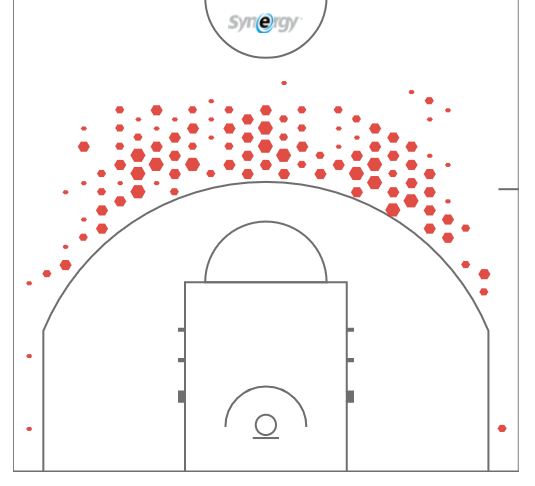
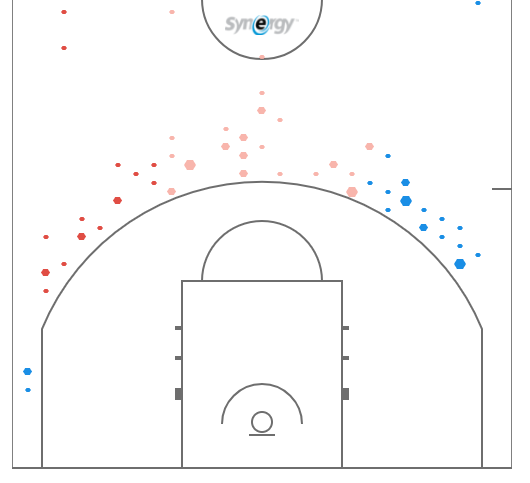
Option 1: Show & Recover (hard hedge) or Catch Hedge. This was used about 10% of the time in the possessions I watched. It had tricky results to sort through, because it succeeded in one sense but failed in others.
The goal would here would be to get two guys on the ball and negate Dame from attacking, then get your screener’s man to recover back to his original man, when Dame’s attack is stymied or he picks up his dribble. It’ll look like a double team temporarily, but you want to bail and get back to your man as soon as he’s deterred from attacking rather than sticking with him like you would in a blitz/double (which are the same thing).
What I learned is that IF you can contain Dame with your big, you’ll be in good shape. If not, it’s easy money for Portland. On film I saw either Dame turning the corner or using a crossover and getting downhill on the big. But when the big was able to keep him in front, it usually negated the action. AD can do that, but JaVale and Howard are less equipped to.
When teams couldn’t contain Dame, he was able to break down the defense and get easy pass outs or get easy looks for himself. I’d describe it as being effective in dampening the team’s efficiency in general, but being more vulnerable for Dame to score himself.
Assuming AD is the big and he can contain, at that point the natural next look to attack for the offense is passing to the big man in the short roll.
The most simple planned counter would be to slip screens. That’s something Portland would have the option to do based on their spacing, which on film is apparent. Our Player Profiles reflected that, showing B+ Spacing for the lineups Dame played within based on our data.
Hard hedges resulted in a Dame shot ~30% of the time and a shot from the screener ~20% of the time. For Melo as the screener it was a lot higher.
Option 2: Blitz (double team) the ball screen, which I saw used ~25% of the time.
The execution of a double team would be similar to a hard hedge, but both players stick on Dame no matter what.
Why blitz? It gets the ball out of Dame’s hands more often than a hard hedge (and far more than a soft hedge). For most players it’ll up their turnover rates, but for Dame he’s too sound as a dribbler and decision maker to make it rise above the levels of hard hedges (which actually had a slightly higher rate for him on the possessions I logged because he tried to do too much). When Dame confronts a blitz he gets the ball out quickly, and that ball is almost always going to the screener
Whiteside’s a 2nd percentile Playmaker and 13th percentile Perimeter Shooter, according to our talent grade data. And POR doesn’t have much playmaking on the roster outside of Dame & McCollum, so a scramble drill scares me less against Portland than it would against other teams.
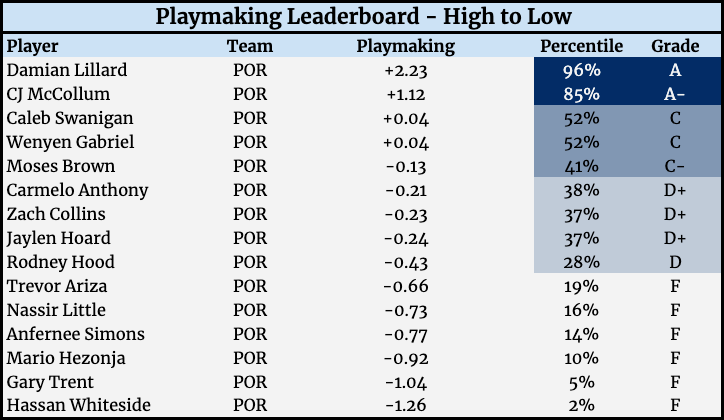
Of all coverage options, Blitzes were the most likely to get Dame to NOT shoot, but were also the most likely for the screener to get a shot. Hard Hedges also gave up shots to the screener (almost always a jumper). Whiteside or Nurkic, that’s fine. For Melo or Collins less so.
Blitzes resulted in a Dame shot ~10% of the time and a shot from the screener ~30% of the time (but for Melo it was a lot higher and it likely would be for Collins as well)
Brooklyn used this against Portland in their bubble matchup and it resulted in quick passes to the screener Nurkic in the short roll almost every time. He missed some open guys and took some questionable shots, so those results looked promising to me. I saw 2 total assist for him on the season from the short roll, and far more bad decisions and opportunities for Portland than good ones.
Here’s what a lot of the Nurkic short rolls looked like:
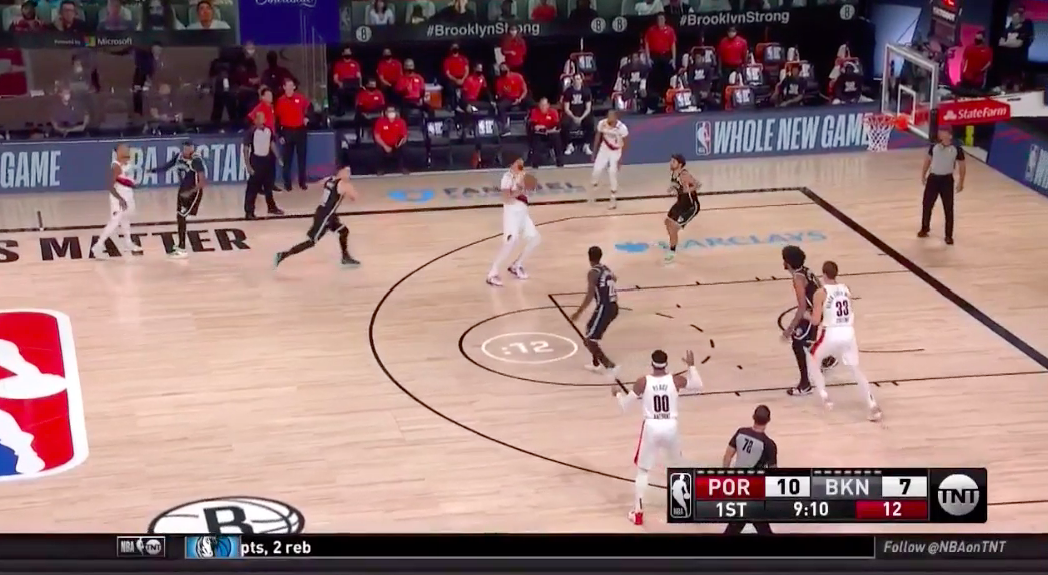
Based on this, I’d blitz with confidence and force Nurkic to be good at something he hasn’t been good at so far. If he can’t, the Lakers win this series in 4 games. If he can, you reassess, pick your poison, and adjust.
Option 3: Switch. This was used about 10% of the time in the clips I watched.
Among screeners, Whiteside is the only guy I saw attack the mismatches with any effectiveness. Melo tried sometimes but wasn’t getting good looks. Dame attacking the mismatch is generally the biggest concern. Dame has an isolation impact ((efficiency – expected efficiency) * attempts) higher per game than 97th percent of the NBA. If you can live with AD against him in space, that’s an option.
Switches resulted in a Dame shot ~40% of the time and a shot from the screener ~10% of the time (for Whiteside it was a lot higher).
Here’s What I’d do
Based on this, I’d blitz on Dame ball screens with Whiteside or Nurkic as the screener. Probably Collins too, until he shoots me out of the coverage. My backup option would be a hard hedge (show & recover). Both options cut into his 3-point volume by big margins.
With Melo as the screener I’d switch. I likely don’t have McGee or Howard on Melo, so I feel pretty good about this approach resulting in Kuz or AD or LeBron on Dame. Let’s pray Kuz’s good footwork continues into the playoffs.
But what is LA’s personnel best for? Well, soft coverage is what they usually use, with switching being the only other coverage used with any regularity. Soft coverage plays right into Dame’s hands, so we’re not doing that. LA hasn’t blitzed much this year, but they’re capable of it. And I believe switching works as well, because it’s unlikely the new defender on Dame will be McGee/Howard based on my game plan as described above.
Dame Lillard Isolation
Dame Time scares the heck out of me. Not just because it’s great offense for Portland, but because it happens all games (but less in the second quarter). Some good isolation players save it for the end of the game, but Portland doesn’t let you off the hook for Q1-3. Dame goes at you all game. Here are his isolation attempts by quarter this season:
- Q1: 68
- Q2: 38
- Q3: 67
- Q4/OT: 75
About 25% of his attempts on the season are from a switch in a pick and roll situation, so that’s worth keeping in mind for how we defend ball screens. When he does isolate, he’s driving 75% of the time (vs taking a pull up without a drive). And when he’s shooting without a drive, only 29 times on the entire season has he taken a pull up 3-pointer and 65 times before he dribbled. As we mentioned before, if you can avoid giving him drop coverage you can cut into his 3-point volume. It’s important to be aware that the volume won’t come in iso, and cover him accordingly. The second he starts his dribble, the fear of a drive and drawing a foul takes precedent here over his pull up 3s.
20% of his scoring possessions were with <4 seconds left on the shot clock. That puts him 6th in volume (behind Harden, LeBron, Dinwiddie, CP3, and Tatum) with an efficiency higher than all of them other than Harden and Tatum.
Usually when he’s taking a jumper (that 25% of the time), it’s usually either against a mismatch (goes to his step back often) or he’s liable to do so from as far back as the logo (not in mismatches).
In terms of him deciding to pass to a teammate, we saw that 20% of the time for his left side isolations, 30% of the time for his right side isolations, and 40% when he attacked from the top of the key.
There’s one clear shot you want him taking once he does isolate:
- 1.2 PPP shot no drive
- 1.2 PPP drive to rim
- 0.76 PPP drive pull up
- On quite low volume he also scored 1.0 PPP on drives where he shot runners
Ideally you get him to drive (and not take a 3-pointer) but also not get to the rim. Wow, really groundbreaking stuff. But the key question is how teams got him to settle for those looks.
From watching every isolation of Dame’s in the bubble, what I found was successful teams stayed tight enough to him in triple threat that he needed to drive, but then had help with guys digging down at the elbows or a low man rotating baseline to wall him off from the paint. If you can keep him out of the paint you can also keep him off the line, which is also critical.
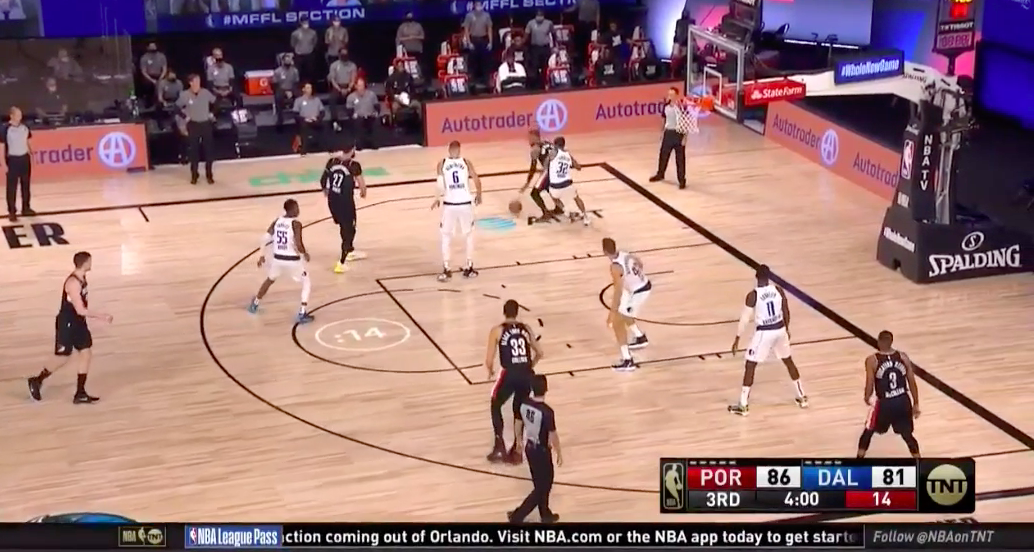
The tricky part is finding guys to help off of. Whiteside, Gabriel, Little, and Nurkic are all guys I’d help off of, but as a whole they’re often not standing around on the perimeter. Collins can shoot a bit better but I’d consider helping off of him also.
Hezonja is someone I’d help off of, but then you have McCollum (A), Trent (B, but white hot right now), and Anthony (B-) all with good to excellent catch & shoot 3-point shooting percentages. Less appealing options there.
When the opportunity is there, help. But don’t do so off of great shooters. Sometimes you just need to put the whiteboard down and rely on good one on one defense.
Speaking of that, I also watched every Dame isolation against the Lakers this season. Here’s what I saw:
- Long pull up 3 missed against AD, who blocked the step back
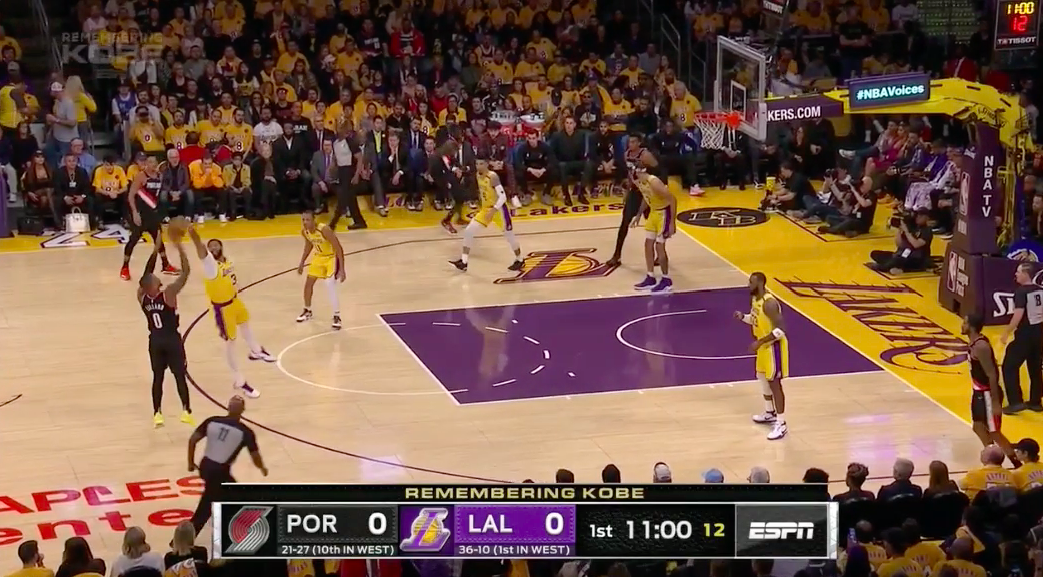
- Drive blow by against Bradley, who AD blocked into oblivion
- Pull up missed against Caruso, who contested the long 2 heavily
- Step back 2 made against Bradley, who couldn’t keep with him
- Step back 2 made against Bradley, who looked silly
- LONG pull up 3 missed against AD from almost the logo, who had his hand down
- Drive blow by against Bradley, who fouled him on the drive
- Step back 3 missed against Caruso, who stayed with him and contested heavily
- Step back awkward 2 missed against AD, who contested heavily
- Drive against Caruso that was blocked by AD but called a goaltend
- Step back 3 missed against LeBron, who contested heavily
- No dribble 3 made against KCP, who had his hands down but contested decently
- Step back missed 3 against Caruso, who contested heavily
- No dribble 3 missed against AD, who had his hand down but was able to contest heavily
- Drive shot against Caruso missed badly, with an almost block by AD
- Drive against AD with a foul drawn
- Fadeaway mid range running 2 made against KCP, who contested the hell out of it
- Drive made against Caruso on a blow by that LeBron almost blocked
That’s 18 isolations against the Lakers in 3 games. Dame shot 6/16, was blocked twice, fouled twice. 13 points on makes, plus another ~3.5 points from FTs (based on his season average FT%), would put him at 0.92 PPP isolating.
Take the isolations where Bradley (who won’t be playing) was guarding him away and his efficiency drops to 0.77 points per possession.
Both are small samples to point just at results and think they’ll be predictive, but in the process leading to those results I saw heavily contested shots, KCP, Caruso, LeBron, and AD being able to almost always stay in front, and AD and LeBron lurking on the back line impacting a lot of shots when Dame was able to drive.
At the end of the day, this is the attack LA can scheme against least effectively. Dame will score points in isolation, and perhaps on high volume. LA’s job will be to mitigate his volume as much as possible through conceding fewer mismatches with players they want him isolating against.
CJ McCollum Pick & Roll
The CJ McCollum pick and roll is a dangerous one, but it’s not in the same tier as Dame. CJ won’t beat you consistently with pull up 3-pointers, so LA can play their base drop or switch defense against him (based on Laker personnel) without altering the game plan much.
Just because he’s not Dame doesn’t mean it’ll be easy though. Back pressure is key. CJ is a guy that’ll hit floaters and take the pull up mid-range 2s. Our 2K-style talent badge system has him with a Gold Difficult Shots badge this season. But he’s less apt to take and make pull up 3s.
For more context, Dame is shooting ~7.5 pull up 3s per game at over 40% on those attempts. CJ is shooting about half that volume and at 30%, which is not efficiency and volume you change your base defense to stop.
Where McCollum is particularly weak in his pick and roll game is getting to and finishing at the rim. His rate of getting to the rim when he uses a ball screen is 2nd worst of the 55 players who had 50+ scoring possessions from ball screens this season. His efficiency among that group of 55 players at the rim was 3rd worst.
In general, CJ gets to the rim well. His 92nd percentile Getting to Rim rating is only behind Dame and LeBron in this series. But his D- Finishing at Rim metric rating, which accounts for his degree of difficulty in its evaluation, puts him 3rd worst in the series, only above Morris and Melo.
Lillard, on the other hand, has elite Finishing data, both getting to and finishing at the rim from his Player Profile:
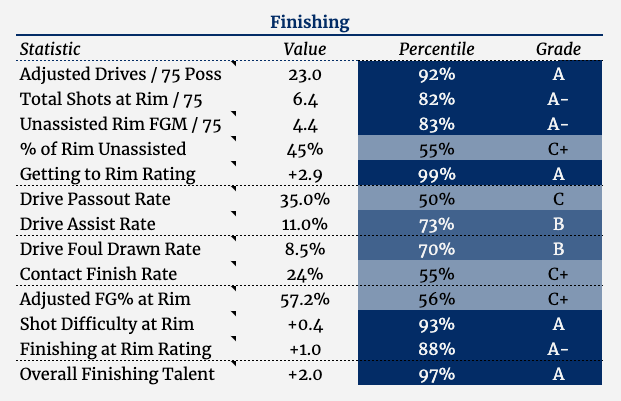
But back to McCollum. He’s good enough of a playmaker and less enough of a threat on those pull up 3s that I feel good about LA keeping with their base drop coverage against a CJ pick and roll. His playmaking if you put two men on-ball compared to the 3-point shooting makes blitzing or hard hedging less worth the risk. Switching would also work, but again you’d want that less when Whiteside is the screener.
Speaking of isolation, McCollum isolations have had a D impact on the season. He has a C- eFG%, C- turnover rate, and C- foul drawn rate in isolating, per his BBall Index Player Profile. LA will live against McCollum in isolation if they get to a switch situation.
CJ will hurt LA with his driving to pass and mid range and perimeter shooting, not driving to score or isolation play.
Jusuf Nurkic Post Ups (& Handoffs, and Perimeter Playmaking)
Nurkic has been efficient on small volume this year posting up, but he was a 33rd percentile efficiency scorer last season from the post. Part of his issues likely relate to the fact he doesn’t have much of a post move repertoire. Nurk has his right handed hook shot and a drop step for when he turns away from that left-shoulder, right handed hook.
I’m not too concerned and don’t want to spend much time on this, since Nurkic’s efficiency and volume likely won’t be game changers and LA has a strong post defense.
What does stand out as key to Portland’s success this series is Nurkic’s playmaking ability. Nurkic improved to an A- Playmaking talent grade last season after starting his career off F, C, C-, and C- his first four seasons in the league.
But here’s the thing, I watched every single Nurkic assist in the bubble, and 95% of them were with him standing stationary at the 3-point line. He’s a great passer making the reads within Portland’s sets and finding guys on their split cuts, back screens, back cuts, and actually most of the assists were simple handoffs to Dame or CJ.
Nurkic is a good passer. But he’s a good passer in choreographed situations where he’s stationary. That’s a playmaker, and a playmaker I’d love to have on my team, but it’s also the kind of playmaker that I’m less scared of and is easier to scheme into poor situations.
The criticality of these limitations of Nurkic (which we also see in his Passing Versatility data even the last two seasons being in the lowest tier), comes because of how I want to play the Dame pick & roll.
Hard hedging and doubling Dame opens up the short roll to Nurkic. But out of all the short rolls to Nurkic during the bubble, I saw more missed or bad passes and poor shot than good passes and assists. If you want to make a shooting star look like a crashing plane instead, let’s force Nurkic to be the off-dribble playmaker in scramble situations. This is the same guy who likely has less chemistry developed with teammates due to being out most of this season.
If we play Nurkic’s assist video reel from NBA Advanced Stats, we can see what some of these plays look like:
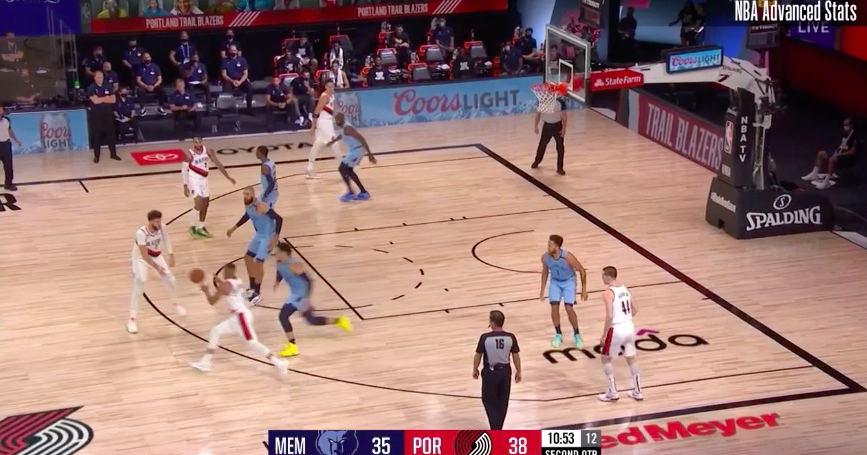
Seriously, go here and you can watch like 50 of these same sorts of looks. From each of these I have a couple thoughts:
- When Nurkic has the ball and the paint is open, overplaying perimeter passes to guys in non-scoring situations opens you up to back cuts that Portland will take advantage of. You don’t need to do that.
- In split cut and flare situations, lock and trail and recover to shooters rather than giving up slips to the rim for dunks.
- In handoff situations, you’re better off doubling the recipient or switching than trying to overplay and giving up a back cut layup. Treat it like a ball screen.
- For all of these, we want strong ball pressure. Get in his face and make it harder for those reads and passes to be made. Between his 80 games last year and this season, he’s driven to the rim on a spot up 10 total times. Get in his face and makes these passes difficult. Overplay him on-ball and see if he’ll put the ball on the floor, because he’s not a driver and absolutely not a playmaker off the dribble.
He’s also the same player who isn’t going to drive and finish at the rim or shoot pull ups. He’ll get some assists in these situations, but you live with that as the Lakers as long as it’s also coming with the turnovers and bad shots from Nurkic.
Going back to his strength, we know he’ll find the open man within their sets, so you can’t botch assignments on their pin downs, handoffs, split cuts, back screens, etc.
One tactic LA can take to mitigate the damage, which I covered above, is ball pressure him. Get in his face and make it harder for those reads and passes to be made. Between his 80 games last year and this season, he’s driven to the rim on a spot up 10 total times. Overplay him on-ball and see if he’ll put the ball on the floor, because he’s not a driver and absolutely not a playmaker off the dribble.
Nurkic, hasn’t been a 3-point shooter his whole career, but hit 2/3 in the play-in game against Memphis after being 2/10 for the rest of the bubble games. He’d need to prove that shot for me to gameplan around it, but keep an eye out for notes on adjustments once the series starts.
He also hasn’t been an average or above average roll man scoring the past few years. He’s slipped efficiently, but not that often, and you’ll normally live with him popping. He scares me the most as a defender and rebounder.
Whiteside Putbacks
Let’s start off by saying that Whiteside is 1st in total putback attempts on the season and has a 98th percentile impact on them.
He had 10 in 3 games against the Lakers. 3.3 per game is right in line with his 3.2 per game on the season. He also had several more offensive rebounds that resulted in reset offense rather than a putback.
Bigger picture, LA is 11th in DReb% as a team. Portland is 17th in OReb% as a team, but Whiteside is the guy doing the damage the Lakers need to be aware of and put a body on. With how frequently their three Bigs like to go after blocks, this is a concern for me.
On film, when Whiteside was boxed out by a big he wasn’t having an impact on the offensive boards. When he was boxed out by a Guard it was 50/50. When he wasn’t boxed out, you just had to hope the ball bounced off the rim in the other direction.
On drives, more than half of his putbacks came from his man attempting to block the shot and giving him a wide open path for the offensive board.
The film and data on the Lakers show they may be susceptible to this:
- JaVale McGee has a -2.5% DReb Success Rate +/-, which is higher than only 11% of the NBA (F grade). His overall 65.9% success rate is a D+.
- Dwight Howard has a -5.2% DReb Success Rate +/-, which is higher than only 2% of the NBA (F grade). His overall 66.0% success rate is a D+.
On film, we see this is due to McGee and Howard often chasing blocks and putting themselves out of position for defensive rebounds. But when they aren’t attempting to block a shot they do both box out often to help their teammates.
Enter Anthony Davis. Despite blocking the shot on 47% of his contests (which is elite, and an insanely high number) and contested a lot of shots, he’s also a strong defensive rebounder. His +4.1% DReb Success Rate +/- is 96th percentile (A grade).
Here’s Anthony Davis’ interior defensive data from his Player Profile:
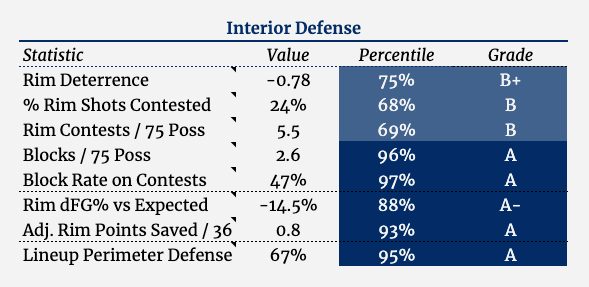
Davis’ 71.2% success rate is a B, but that’s lower than other Bigs because he’s often in contested situations (higher than 83% of players) and due to his versatility he’s further from the rim on his defensive rebounds than 76% of Bigs. But from his Success Rate +/- we know he’s an elite defensive rebounder.
The combinations LA uses also play a role on how well they’ll suceed on the defensive boards. Of the Lakers’ 39 2-man lineups that have played 250+ minutes this season, AD and Howard and AD and McGee were two of the top groupings at lowering the opposing team’s OReb%.
The Kuzma and Davis pairing had the 6th worst rate of giving up offensive boards among all 39 pairings.
And in fact, Kuzma appears 8 times in those 39 pairings. SEVEN of those 8 groupings were among the 13 worst defensive rebounding groupings. The only one that wasn’t was with Howard, who finds himself all over the top of the leaderboard and apparently can overcome Kuzma’s lack of effort and ability on the defensive boards.
The Laker Guards and Wings are also key in this equation. In this tweet I note that V backs, like we see Draymond Green point out in the original clip, are a key thing Caruso does to help protect LA from offensive rebounds when their shot blockers are contesting shots at the rim. A Guard or Wing may not always keep Whiteside from getting the offensive rebound, but it’ll improve their odds.
It’ll come down to hustle, grit, boxing out, and team rebounding to mitigate Whiteside’s impact on these looks generating extra offense.
In addition to those 5 highlighted actions, here are some notable “finishers” worth keeping an eye on but not game planning directly around:
Gary Trent Jr.
Trent is incredibly efficient, but doing just about all of his offense finishing what others create. That’s not to say he’s just putting in easy looks, because he has an A- Shot Making rating on 3s this season while adjusting for degree of difficulty. He also has an A- for his 3-point Shot Creation, showing he’s able to create his own 3-point looks.
But he’s not an iso threat, isn’t using the pick and roll much, and is mostly a floor spacer that isn’t getting to the rim. His Stationary Shooter offensive archetype is appropriate for his job on offense.
Here’s Trent’s Perimeter Shooting data from his Player Profile:
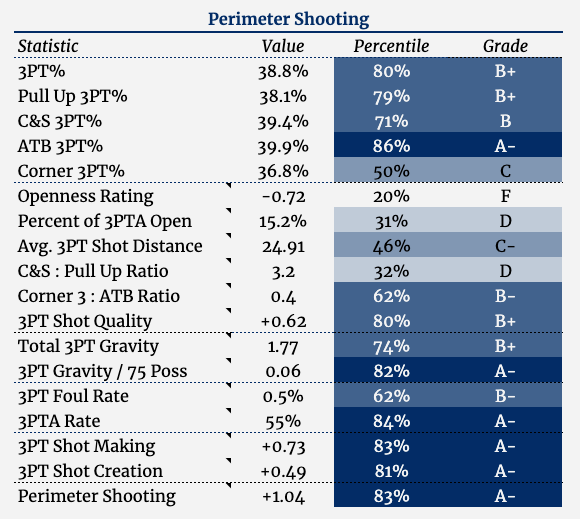
Trent’s job for Portland is making you pay by knocking down shots when a primary attack breaks down the defense. Here’s an example of a blown coverage against the Step Up Fist play we discussed above:
Alex Caruso, if on Trent at all, can’t ball watch like we’ve seen him get burned by very notably against Toronto. He’ll hit some tough shots, but I’m not adjusting my game plan around him.
Carmelo Anthony
Melo will try to create his own shot, but I’m perfectly happy letting him grab his 0.8 points per possession isolating all day long. Most of that isolation offense is post up one on one play, where he has an F impact and F potential assist per pass out data.
Based on that we know he’s a post up black hole. But did you know he also has a THIRTY THREE TO ONE ratio of perimeter isolation scoring possessions to pass outs leading to any kind of offense for Portland, which is even worse.
Melo is an effective catch & shoot 3-point shooter, but his self-created offense isn’t useful at this point and not worth trying to deter, unless Portland is able to get him on KCP (which is the one mismatch he can abuse).
He has his bright spots, and is a much improved player from the out of shape player we saw in Houston, but is still a diminished player vs his old self with his playmaking, off-ball movement data, and with getting to and finishing at the rim. He still tries to create, but he’s not his old self in that way. But occasionally see games where he goes off as an isolation scorer, but it likely won’t be what hurts the Lakers. What’ll hurt them is him going off as a finisher after Dame/CJ break down the defense.
For fun, in terms of his offensive style, here are the players his Synergy play type distribution (P&R, iso, post ups, putbacks, etc.) most closely resembles:
- 2017-18 Zach Randolph
- 2014-15 Markieff Morris
- 2018-19 Joel Embiid
- 2013-14 Markieff Morris
- 2016-17 DeMarcus Cousins
- 2014-15 LaMarcus Aldridge
- 2018-19 Karl-Anthony Towns
- 2016-17 Brook Lopez
- 2018-19 Jaren Jackson Jr.
- 2013-14 Josh Smith
His talent profile, based on our 11 talent metrics, most closely resembles:
- 2018-19 DeMarre Carroll
- 2015-16 Charlie Villanueva
- 2014-15 Ersan Ilyasova
- 2018-19 Moe Wagner
- 2019-20 Lauri Markkanen
- 2013-14 Anthony Randolph
- 2014-15 P.J. Tucker
- 2015-16 Trey Lyles
- 2013-14 Quincy Miller
- 2014-15 Marvin Williams
He’s not the old Melo, but he’ll still have his moments. But most of those are the off-ball looks finishing, rather than creating. It’s true Olympic Melo, the same mindset and approach we’ve hoped for him to take and have seen him resist for several years.
POLL BELOW: What role/playing time should a player like this have on a playoff team?
More info:
🏀 Offensive Archetype: Versatile Big
🏀 Defensive Role: Perimeter Big
🏀 F Roll Man impact, D+ Off Screen eFG%, F Cut FG%
🏀 Overall Impact: C (PIPM), D (RPM), D- (BPM), F (RAPTOR) pic.twitter.com/GmMxOQ2g4c— Cranjis McBasketball (@Tim_NBA) August 15, 2020
I posted screenshots and information from his Player Profile on twitter Saturday and asked whether a player with that data best aligned with a Starter, 6th Man type, Bench Role Player, or out of rotation playoff player in a vacuum on a playoff team. Slightly less than 6% of respondents said Starter. 20% said not in rotation, while about 63% said bench role player.
The thing is, Melo has started 100% of Portland’s games this season on high minutes. It’s time to punish Portland for that.
Zach Collins
Collins was a good popper last season and an improved perimeter shooter, but probably not one that’ll do much damage. I’m fine letting him pop or space the floor and be someone I help off of. I’m also happy if he wants to isolate or post up against LA.
Here’s how his talent grades look in our Multi-Year Talent Grades tool:

Also notable is Portland’s lack of finishing. When Dame isn’t in the game, I’d consider going small and being fine taking a hit to my rim protection without Howard/McGee in the game and letting AD play the 5. Benefit on offense without facing much of the consequences defensively, as long as you box out Whiteside, which is the only strong offensive rebounder Portland has. But if you can play him off the court, then it’s all systems go for small ball. LA may not go that route, or even need to go that route to win this series handily, but it’ll be something to watch for.
How I’d Attack Portland’s Defense
Portland’s defense is not good, but they do have some particular strengths and weaknesses to be aware of and take action on.
To start, here are defensive impact numbers for Portland players from their Defensive Player Impact Plus-Minus:
- Nurkic: A (2018-19)
- Whiteside: A
- Hezonja: D
- Melo: D
- Little: D-
- McCollum: F
- Trent: F
- Lillard: F
That’s not good at all.
In addition, according to our Perimeter Defense talent grade, Portland’s Guards rank 28th among Guard position groups in the league. Their Bigs, compared to ratings of other Bigs, rank 27th. Very exploitable.
Using the Pick & Roll
The LeBron & AD P&R has been incredibly efficient this season, and the talk about it being negated with switching has been pretty unwarranted from the film I’ve seen. Defenses mostly soft hedged against it, and LA scored well against those.
In switch situations, which I logged as happening around 25% of the time against the combo in the 10 random games I picked, LA definitely had a direct shot from LeBron less, but AD did well against mismatches down low and LA has enough ball movers to attack a compromised defense and ended up with a lot of good looks and efficient possessions. I logged those possessions as still being above 1 point per possession, which I’d be happy with.
All of that said, Portland isn’t most teams. Portland is the 7th worst overall pick & roll defense (per Synergy) and 4th worst on passes from the ball handler for a reason. Their personnel lacks switchy Wing defense, and Hassan Whiteside is one of the league’s worst ball screen big man defenders.
Here are Portland’s ball screen defensive tendencies, based on what I logged in their bubble games:
- Drop Coverage: 48%
- Ice: 24%
- Switch: 18%
- Soft Hedge/Hard Hedge/Show & Recover: 7%
- Blitz/Double: 4%
I’d put Little in ball screen situations as the big man defender also, but Whiteside in particular exhibits zero desire to play soft coverage with any technique. All of what makes bigs like Brook Lopez and Marc Gasol so effective with being close enough to contest while conceding ground and staying in front is far from what we see with Whiteside, where often his coverage would be more correct to just label as “none,” rather than playing a real drop coverage.
I mean, look at this.
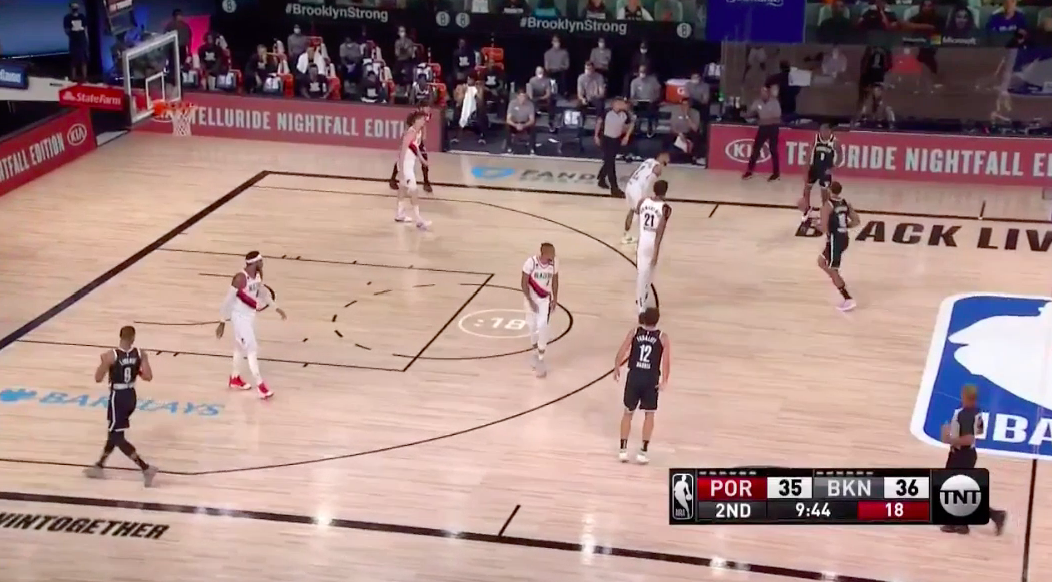
Or this.
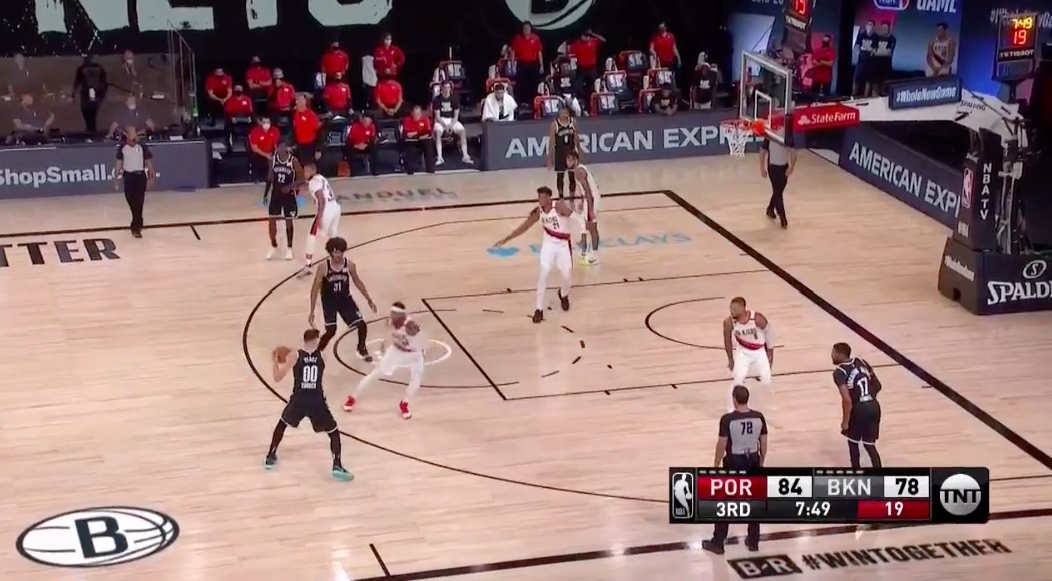
This is frustrating.
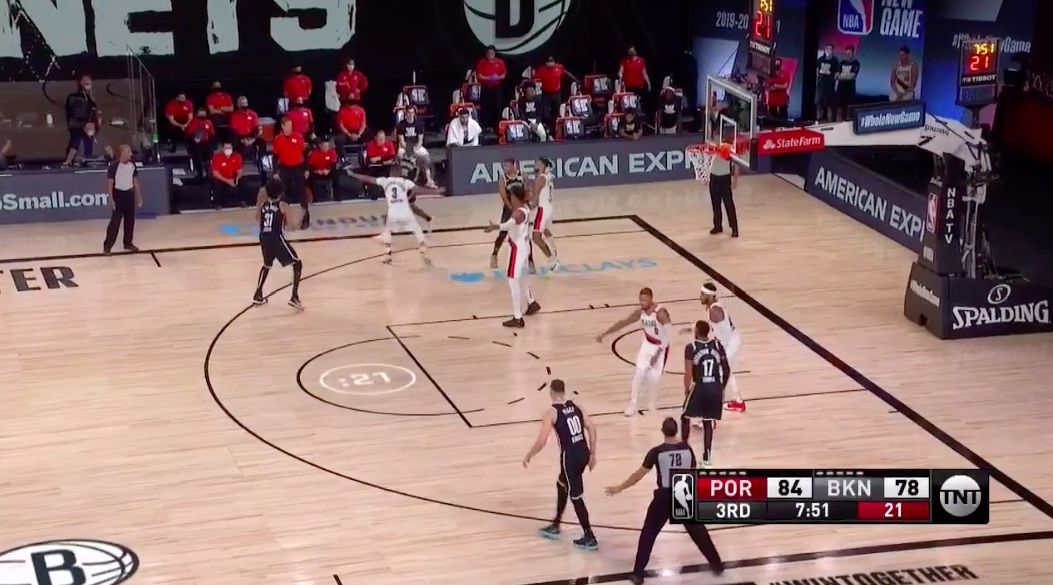
Look for the Lakers to pound pick and roll against Portland, targeting Whiteside and Little specifically. Nurkic is strong in ball screen big man situations, but is someone you can drive on from the perimeter (in a mismatch situation or with AD).
LA can also put McCollum, Melo, and Hezonja in ball screens as the ball handler defender. While he has his issues, Dame is actually very good defending in those situations and less worth targeting, in my eyes.
Off-Ball Defensive Weaknesses
If Carmelo Anthony is defending you off-ball on the perimeter, move. Melo tends to ball watch and over help in situations where he isn’t the designed help man, which puts him out of position if you move from the corner up to the wing or from the wing to the corner. Because he gets himself out of position so often, he’s often flailing back to his man and his closeouts lack technical soundness, opening him up to be driven past or taken completely out of the play if you pump fake.
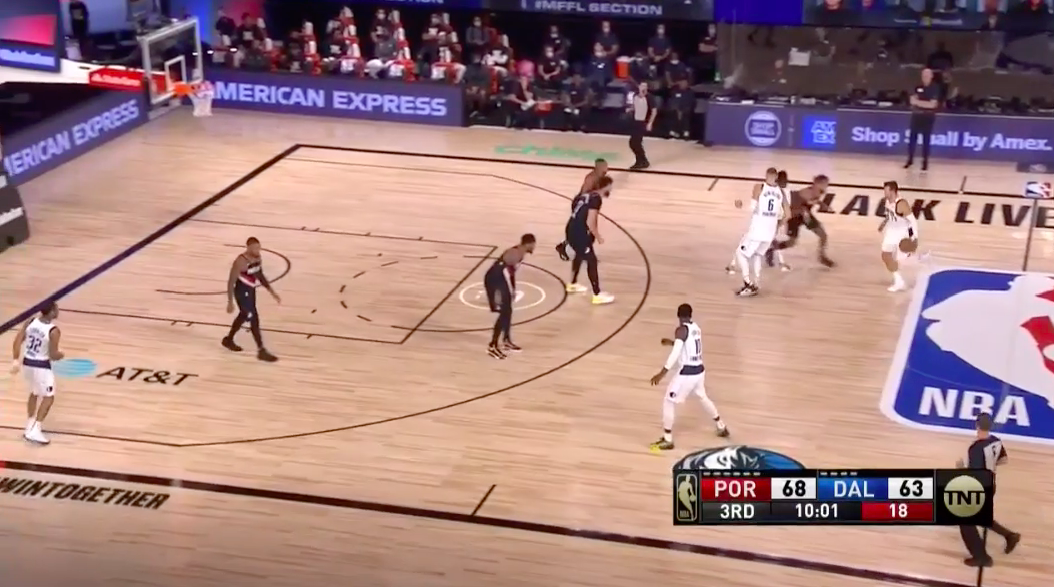
Some of the same things can be said about Dame Lillard. He’s a good ball screen defender and decent on-ball, but off-ball he likes to ball watch and gets burned with cuts, off-screen action during drives, and players fading from the wing to the corner or lifting from the corner to the wing.
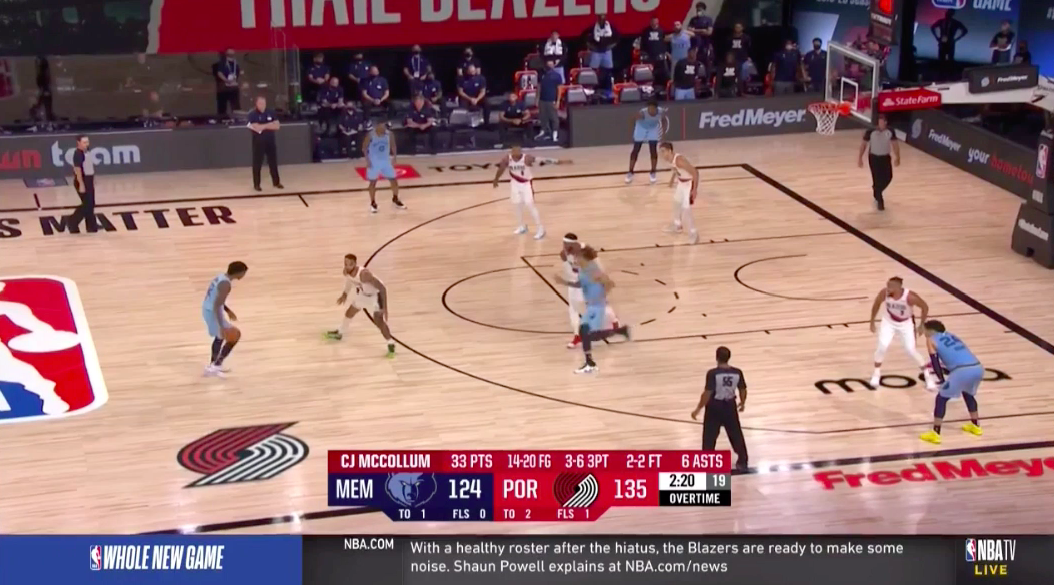
The Lakers have Movement Shooters (per their Offensive Archetypes), like Kyle Kuzma, Kentavious Caldwell-Pope, Danny Green, and Dion Waiters, that’ll take advantage of this off-ball defense.
In terms of Passing Lane Defense (Deflections & Interceptions) and Pickpockets (on-ball steals), Portland has a couple guys to watch out for. Here’s their data from our Leaderboards tool, but keep in mind that not everyone here is still on the team or will be playing during the series:
Trent, Hezonja, and Gabriel impress by these two measures, while a lot of other Blazers are less active in these ways.
Attacking Portland’s Post Defense
LeBron James will do his thing, running the pick and roll and isolating to create for himself and others. That will happen, particularly against the personnel Portland has to defend him. And on that note… who will Portland defend him with? The only two players on their roster in the Wing Stopper defensive role are out for the season. LeBron’s going to dominate.
Five minutes of daydreaming later and we’re back to Portland’s post defense. LeBron will do his thing, and Anthony Davis will get his fare share of roll man looks and dunks, but his post up offense is the other way Davis likes to score on offense.
But I don’t like this matchup for Davis. Portland has the 2nd best defensive efficiency on the season defending the post, and AD already isn’t nearly as dominant of a post scorer as he is a roll man.
While some may be confident in AD dominating the post game. I’m not.
Let’s talk about what leads to Portland’s second best defensive efficiency defending post ups. When the ball goes into the post, everyone gets a foot on the paint and there’s lots of ball watching. This makes them a prime candidate to be flare screened and cut against, but it’s also the type of defense that can give AD problems and result in more jumpers from the post.
Only 2-3 possessions total did Portland even zone up weak side, which also makes them more vulnerable to pin ins. Here’s one of the few examples I could find from bubble play:
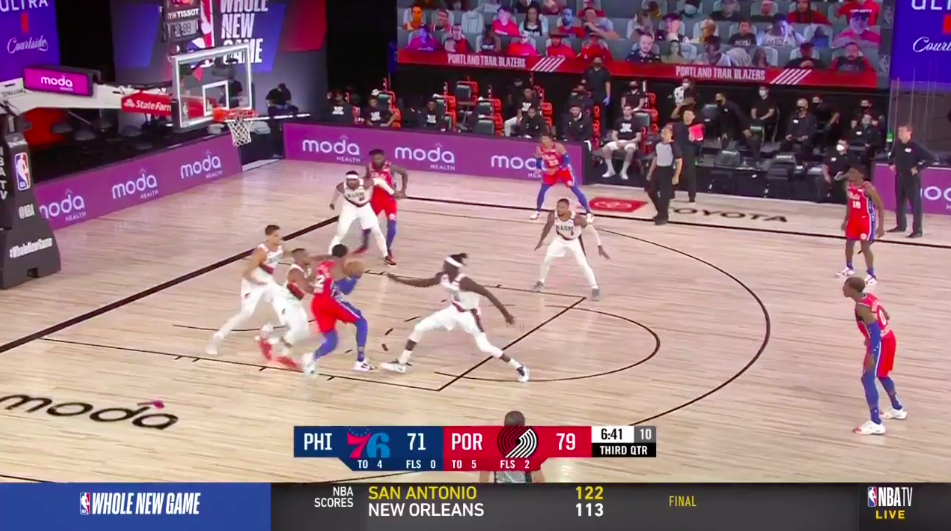
It’s worth noting their Bigs will leave their assignments completely to help down low and there’s a mismatch if their man is a non-shooter. This, again, makes them vulnerable to flare screens.
Denver, Sacramento & Phoenix had movement off-ball during their post ups and got good looks for pass outs, cutters, and also for their post players (with the defense being able to sag less). Usually the good looks were on the perimeter, because the defenders continued to ball watch and load up to the ball. Philly, Boston, and Houston were stagnant, and we saw the defense sag down further because of it to cause more chaos in the post.
Here’s what Portland’s base post defense will often look like. Five players with a foot on the lane line:
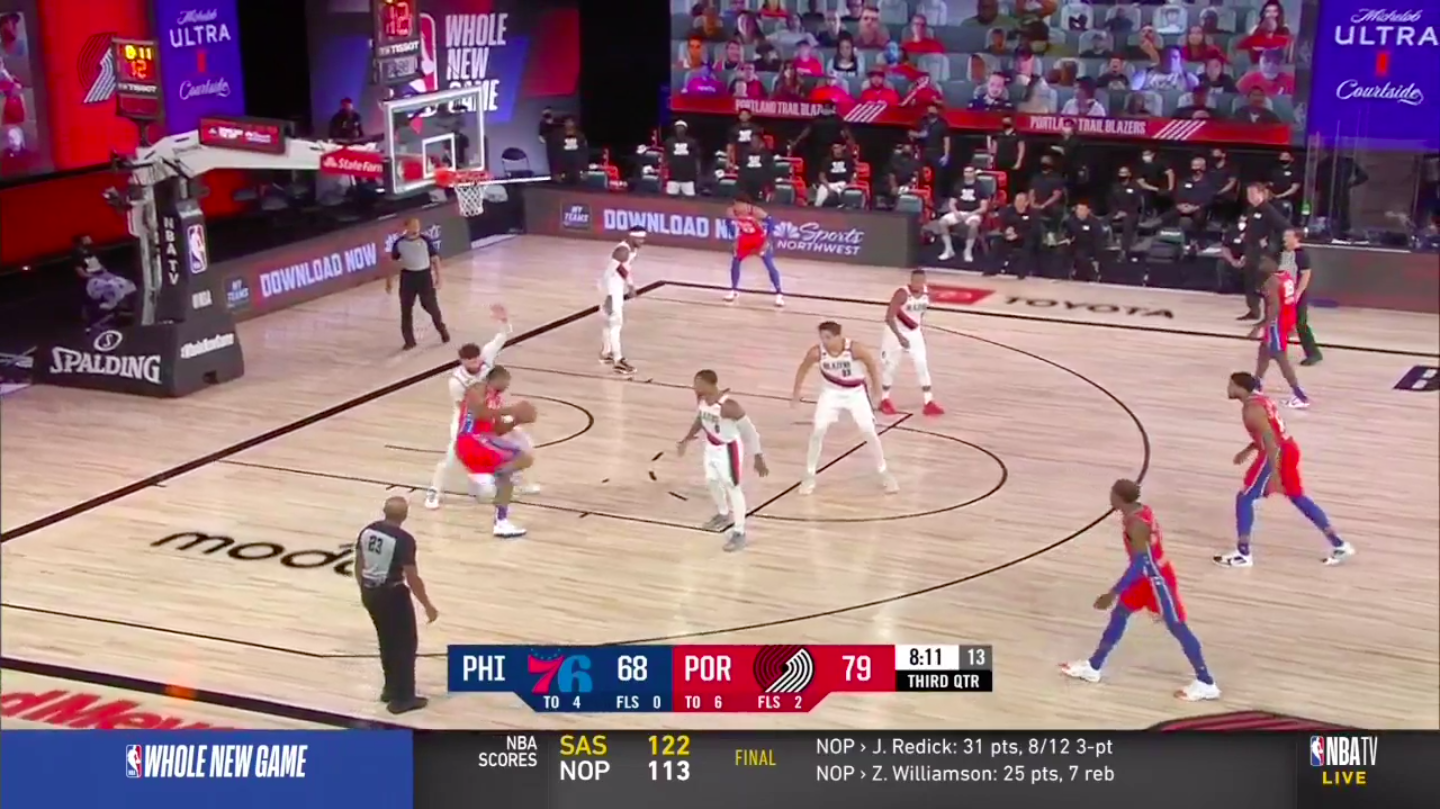
Portland also uses strong side digs when the ball goes into the mid and low post. It’s not a double, but it’s enough to disrupt. This will make them vulnerable to flare screens, but LA doesn’t do much of that.
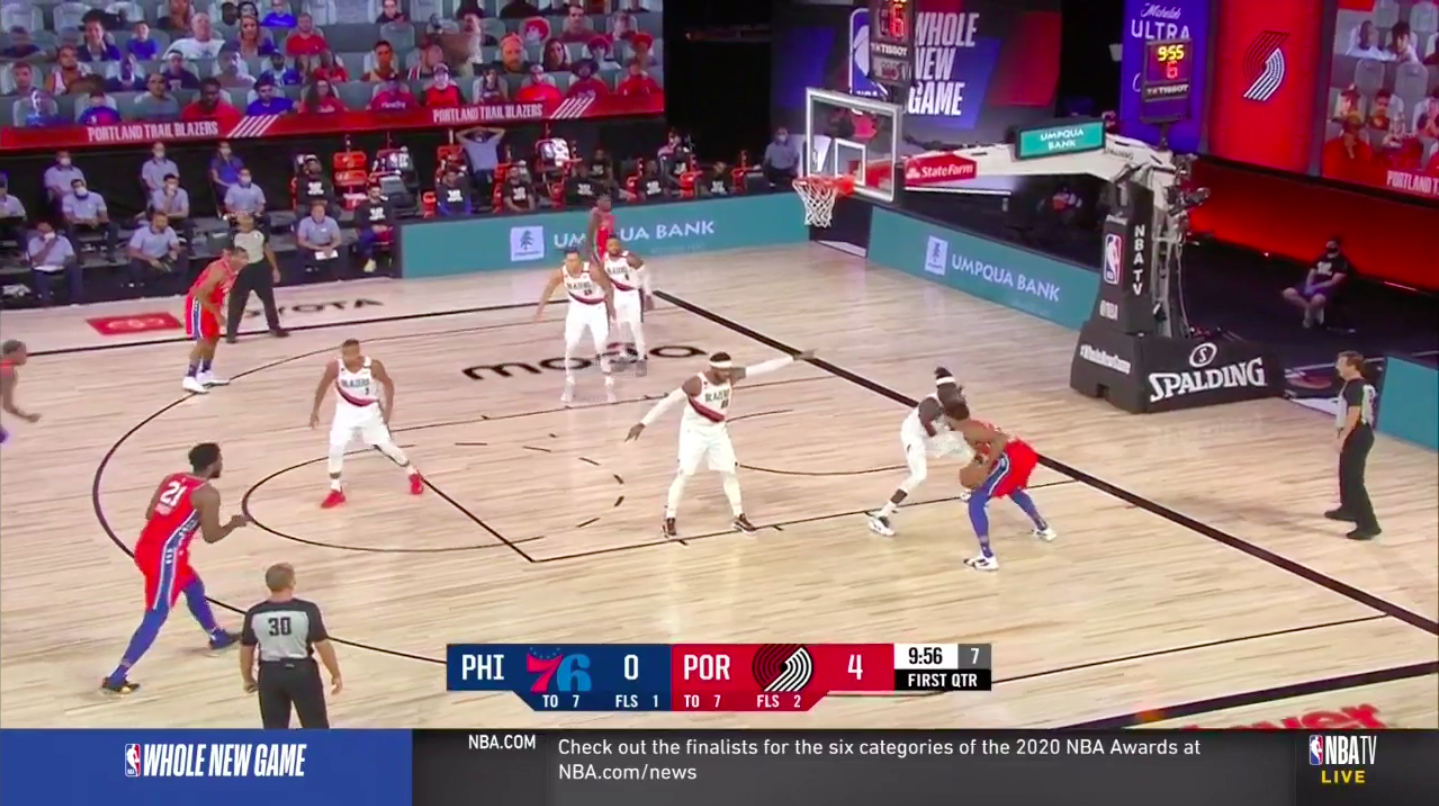
With that base defense, LA needs on-target passing from LeBron and AD on kick outs, guys ready to let it fly when they’re open, and preferably would get action happening off-ball in the post, which haven’t been happening this season much at all on post ups. Before the hiatus and lately during bubble play they’ve had more cutting, but I haven’t seen much at all in terms of split cuts or flare screens. If they were ever to start, now would be a hell of a time.
Portland also flops ALL THE TIME down low, so AD and especially Dwight need to be careful. Why Dwight? 9.1% of his minutes this season have been played in foul trouble, which is worse than 94% of NBA players.
Regarding matchups and mismatches, Nurkic and Whiteside would be players I’d have the least interest in posting up against. Collins and Anthony have been more average defending the post, and are likely worse than that as individuals but due to the team’s scheme have had their success rates enhanced. Going at those two or Portland’s guards would be more desirable than going at Nurkic or Whiteside, but neither should yield easy buckets to AD. Particularly with his style being geared toward harder shots and more jumpers.
In terms of actual double teams, I didn’t really see much at all on film. I wouldn’t anticipate them coming based on Portland’s tendencies. But that’s only half the analysis.
So that’s the defense. What does AD bring to this matchup?
AD is an average efficiency post scorer. He’ll have games where he goes off, but most of that is usually spotting up and as a roll man, not a post scorer. He’ll have a game every now and then where he does, but that’s not the norm. In this matchup it’s even less likely.
Don’t believe me? Overall AD is a below average efficiency post scorer no matter how you cut the sample. Among all post players with 10+ looks this season he was more efficient than 45% of them. Among the 36 players who posted up 100+ times he was 25th in efficiency (31st percentile). His eFG% vs that group is worse than 86% of players. But he draws a lot of fouls, with him getting to the line higher than 83% of those post players.
AD’s style in the post is one less geared toward efficiency based on the types of shots he takes, with his Post Style Rating being a D grade. So he already takes tougher shots naturally. If I’m a defense, I just want to not foul and let him take those tough contested 2-pointers.
Here’s a look at Davis’ Post Play data from his Player Profile:
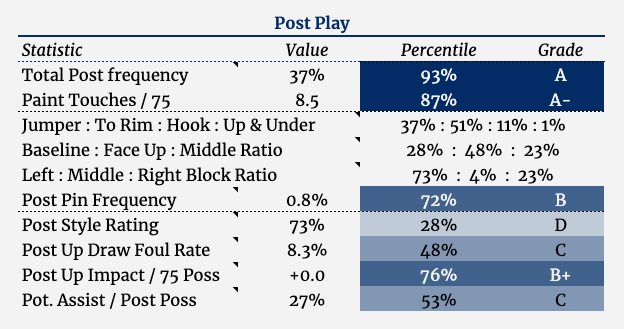
When it comes to trying not to foul, it’s important to know how AD is drawing those fouls. When he turns baseline from either block, he’s drawing a foul 22% of the time. When he turns middle, the rate is half that. When he faces up, it’s about 13% of the time. The reason for this is that when he turns middle, he’s almost always either taking a hook shot or a jumper. When he goes baseline, about 80% of the time he’s going up strong to the basket. A big part of the reason this draws more fouls for him is how in those situations he’s shooting with his right hand, which is closest to the defender, and he’ll lean right into that contact.
Here’s what that often looks like. And in this example, you can see what a double coming on the dribble looks like when you bring it to the middle but then also sit on him middle, opening up a baseline spin. You’d want either his on-ball guy sitting baseline or the help coming baseline.
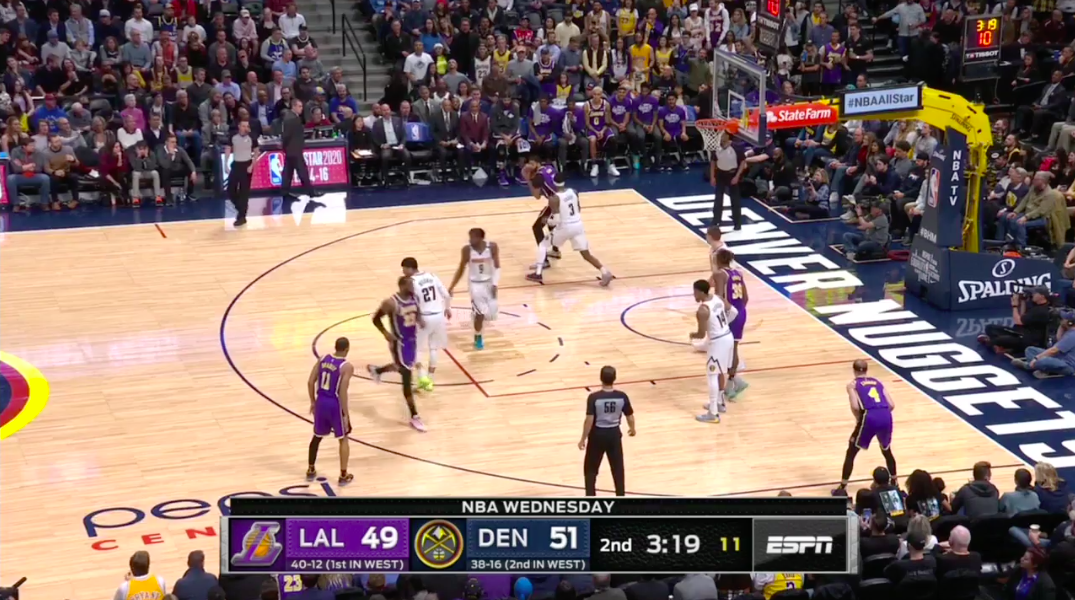
If I’m defending AD, I want to sit on the baseline spin, or have my low big man opposite sag into the paint and wait on the spin while I zone up weak side. Not hard enough that it’s a double until he dribbles into it, at which point he’s not going to be able to successfully pass out of it with any regularity. The goal would be to not concede easy kick outs before the pressure is there. If Portland can do this, and not bite on pump fakes, they’ll defend AD well down low.
Also worth considering is that Davis is an average passer out of the post when it comes to creating potential assists for teammates, and there’s no reason to make those passes easier. On hard doubles this year against AD in the post, he’s passed out on 90% of them and LA has scored 1.0 PPP as a result. That’s significantly higher than his efficiency single covered.
Here’s what post doubles against AD have looked like when you go too early (when he hasn’t put his head down):
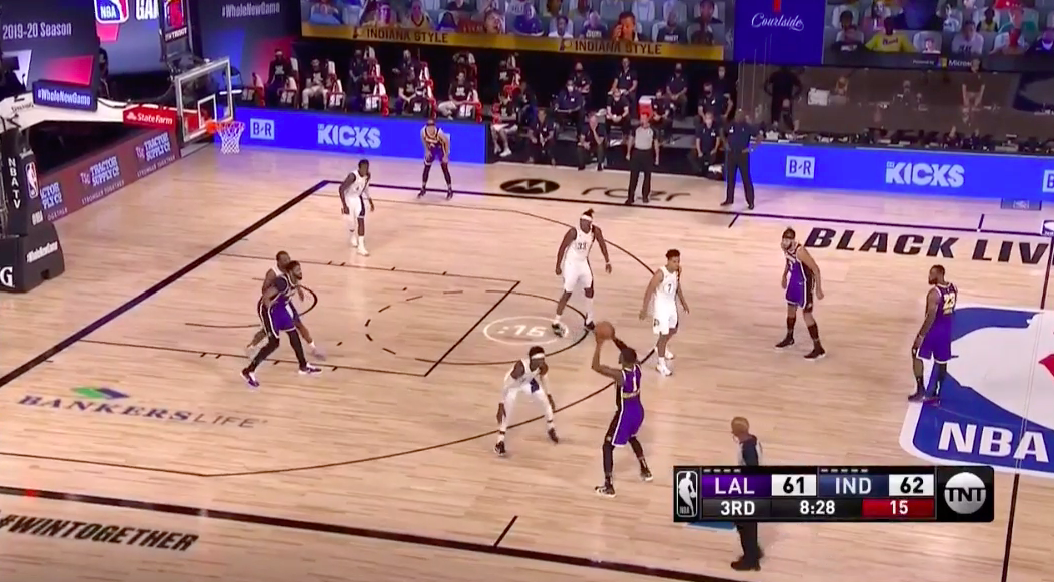
That, along with Portland’s defense being geared toward stopping opposing Bigs down low already and without double teaming, solidifies my belief that double teaming Davis and living with the results would be poor judgement opposing the scouting report by Portland.
Zone
Portland went to a zone defensively 14th most often of all 30 NBA teams, had the 5th least success with it from an efficiency standpoint. I only saw 2-3 on film, so nothing spectacular or worth digging into from my perspective.
I wouldn’t be surprised if they gave it a try early in the series to gauge LA’s response, then decide if it’s worth not abandoning. They also use it for baseline out of bounds plays, which I’d bet we do see. The Lakers had the 2nd most efficient baseline out of bounds offense this season, and we may see that take a step back against Portland’s zone.
So, how would I attack Portland?
I’d let LA be themselves and do what they normally do, but with the awareness that AD may struggle attacking down low against a strong Portland post defense. To get him going with his post offense I’d look to generate some mismatches with back screens, cross screens, and on-ball screens with LeBron (like the step up secondary break we discussed above).
The pick and roll should work well, and I’d bet Dion and Kuzma should be able to provide good offense off the bench against Portland’s poor defenders.
From our data viz pages found here, we know that Melo and Whiteside will likely be on the court for high minutes and during clutch time. That provides two defenders to attack, along with the two key Guards for Portland that both happen to have F defensive impact by D-PIPM. LA will have lots of options to choose from for how they want to attack.
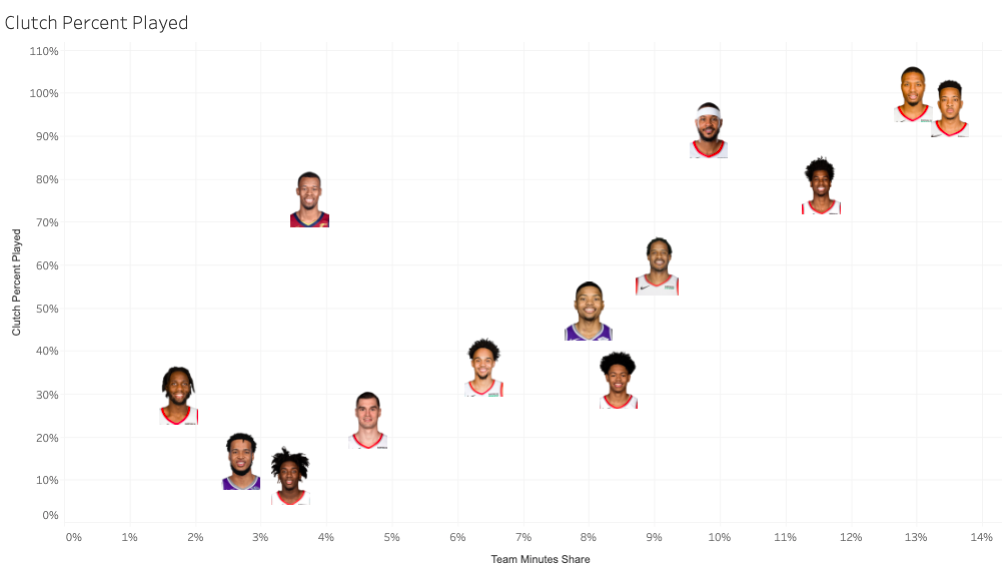
Initial Series Prediction
Portland has fought hard to get to where they are, but they should face an overwhelming Laker offense and a defense prepared and able to negate some of their top attacks. I’ll say Lakers in 5.
To make this a competitive series it’ll take AD insisting on scoring against non-mismatches in the post, LA soft hedging Dame ball screens, Dame Time dominating, the Lakers missing open 3s, and getting several vintage performances from Melo. It’s not impossible, but we’ll need to see LA’s coaching staff drop several balls and Portland have elite performances from top players consistently to push this one to 6 or 7 games.
At the end of the day, LA still has room for error defensively with how much of a mismatch they should be for Portland’s defense. Regardless, I bet it’ll be a fun series.
Coverage Moving Forward
I plan to post articles around what we’re seeing game by game, which sets are and aren’t working, which matchups are being targeted, how rotations are forming, and which adjustments I’d like to see moving forward. In-game I’ll have analysis as well.
If you’ve made it this far you’re a true Laker fan and quite a champ. I can’t wait to enjoy these next couple weeks with each of you. I’ve had a long journey over the past few seasons on Lakers Twitter, all without playoff Lakers basketball, and this will be a nice culmination of years of agony to enjoy together with all of you.
Speaking of champs, shoutout to my girlfriend for her flexibility with me spending countless hours watching film and working to put this article together, as well as for creating the graphic for this article. Thanks, babe <3.
If you’ve enjoyed these ~10,000 words of analysis, support our site and check out our $5/month (or $52.50/year) Data & Tools package which gets you access to just about everything I used in this article. 500+ Player Profiles with hundreds of metrics in each, our Leaderboards tool, our Talent Grades, our Data Viz pages, our Versatility and Gravity applications, and more!
And as always, follow me on Twitter @Tim_NBA and the site @The_BBall_Index for more Lakers and NBA coverage.
